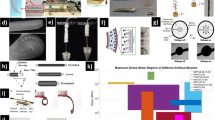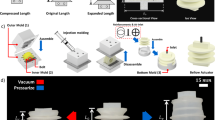Abstract
When robots and human workers team up, safety should be ensured at all times. In order to improve safety of human–robot collaboration in hybrid manufacturing processes, many different types of compliant robotic drives, serial elastic actuators for instance, have been developed to date. However, most of them still consist of rigid mechanical components in combination with prevailing servo motor and thus bring several disadvantages such as poor power-to-weight ratio. This paper presents our solution approach for realization of biomimetic, inherently compliant artificial muscles based on dielectric elastomer actuators (DEAs). The artificial muscles based on DEAs distinguish themselves from conventional actuators through their favorable characteristics. They (a) work noiseless, (b) feature specific energy density comparable to human skeletal muscles and (c) are capable of storing or even recovering energy, and finally, (d) can adjust their geometry to meet with undefined and unstructured objects or environments. With remaining challenges overcome, the DEAs are expected to provide a significant contribution to safety of industrial robots collaborating with human workers.





Similar content being viewed by others
References
European Commission (2013) Symbiotic human–robot collaborations for safe and dynamic multimodal manufacturing systems. Horizon 2020 work programme 2014–2015 Part 5. ii, pp 76–77
Hedelind M, Kock S (2011) Requirements on flexible robot systems for small parts assembly: a case study. IEEE Int Symp Assem Manuf 2011:1–7
Krüger J, Lien TK, Verl A (2009) Cooperation of human and machines in assembly lines. CIRP Ann Manuf Technol 58(2):628–646
Ramer C, Reitelshöfer S, Franke J (2013) Automatisierte Pfadgenerierung und Kollisionsüberwachung für Sechsachs-Industrieroboter durch 3D-kameragestützte Umgebungserfassung. Der 14. Branchentreff der Mess- und Automatisierungstechnik (AUTOMATION 2013)
Matthias B, Oberer-Treitz S, Staab H, Schuller E, Peldschus S (2010) Injury risk quantification for industrial robots in collaborative operation with humans. In: 41st international symposium on robotics and 6th German conference on robotics 2010, pp 1–6
Albu-Schäffer A, Eiberger O, Grebenstein M, Haddadin S, Ott C, Wimbock T, Wolf S, Hirzinger G (2008) Soft robotics. IEEE Robot Autom Mag 15(3):20–30
Ham R, Sugar T, Vanderborght B, Hollander K, Lefeber D (2009) Compliant actuator designs: review of actuators with passive adjustable compliance/controllable stiffness for robotic applications. IEEE Robot Autom Mag 16(3):81–94
Brochu P, Pei Q (2010) Advances in dielectric elastomers for actuators and artificial muscles. Macromol Rapid Commun 31(1):10–36
Zhao X, Suo Z (2008) Electrostriction in elastic dielectrics undergoing large deformation. J Appl Phys 104(12):123530
O’Halloran A, O’Malley F, McHugh P (2008) A review on dielectric elastomer actuators, technology, applications, and challenges. J Appl Phys 104(7):71101
Kornbluh RD, Pelrine R, Pei Q, Oh S, Joseph J, Bar-Cohen Y (2000) Ultrahigh strain response of field-actuated elastomeric polymers. In: 7th annual international symposium on smart structures and materials (Proceedings of SPIE 3987), pp 51–64
Pelrine R, Kornbluh R, Joseph J, Heydt R, Pei Q, Chiba S (2000) High-field deformation of elastomeric dielectrics for actuators. Mater Sci Eng C 11(2):89–100
Bauer S, Bauer-Gogonea S, Graz I, Kaltenbrunner M, Keplinger C, Schwödiauer R (2013) 25th anniversary article: a soft future: from robots and sensor skin to energy harvesters. Adv Mater 2013:1–13
Biggs J, Danielmeier K, Hitzbleck J, Krause J, Kridl T, Nowak S, Orselli E, Quan X, Schapeler D, Sutherland W, Wagner J (2013) Electroactive polymers: developments of and perspectives for dielectric elastomers. Angew Chem Int Ed 52(36):9409–9421
Lotz P (2009) Dielektrische Elastomerstapelaktoren für ein peristaltisches Fluidfördersystem. Disserataion, Technische Universität Darmstadt
Lotz P, Matysek M, Schlaak HF (2011) Fabrication and application of miniaturized dielectric elastomer stack actuators. IEEE ASME Trans Mechatron 16(1):58–66
Franke J (ed) (2013) Räumliche elektronische Baugruppen (3D-MID): Werkstoffe, Herstellung. Montage und Anwendungen für spritzgegossene Schaltungsträger. Carl Hanser Verlag, München, pp 78–81
Landgraf M, Reitelshöfer S, Franke J, Hedges M (2013) Aerosol Jet Printing and lightweight power electronics for dielectric elastomer actuators. In: 3rd international electric drives production conference (E|DPC 2013), pp 170–176
Claussen KU, Giesa R, Schmidt HW (2014) Longitudinal polymer gradient materials based on crosslinked polymers. Polymer 55(2014):29–38
Carta R, Jourand P, Hermans B, Thoné J, Brosteaux D, Vervust T, Bossuyt F, Axisa F, Vanfleteren J, Puers R (2009) Design and implementation of advanced systems in a flexible–stretchable technology for biomedical applications. Sens Actuators A 156(2009):79–87
Jager EWH, Masurkar N, Nworah NF, Gaihre B, Alici G, Spinks GM (2013) Patterning and electrical interfacing of individually controllable conducting polymer microactuators. Sens Actuators B 183(2013):283–289
Acknowledgments
The fundamental research on artificial muscles presented in this paper has received funding from the Bavarian Environment Agency within the framework of the biomimetic research initiative “Bionicum Forschung”. The authors gratefully acknowledge this financial support.
Author information
Authors and Affiliations
Corresponding author
Rights and permissions
About this article
Cite this article
Yoo, I.S., Landgraf, M., Ramer, C. et al. My new colleague has artificial muscles: a DEA based approach for inherently compliant robotic systems. Prod. Eng. Res. Devel. 8, 711–717 (2014). https://doi.org/10.1007/s11740-014-0564-9
Received:
Accepted:
Published:
Issue Date:
DOI: https://doi.org/10.1007/s11740-014-0564-9




